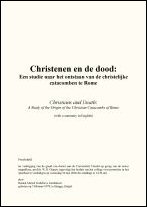
Christenen en de dood: Een studie naar het ontstaan van de christelijke catacomben te Rome. / Renaat Marcel Godelieve Jonckheere - [S.l.] : [s.n.], 2006 - Tekst. - Proefschrift Universiteit Utrecht


 |
Christenen en de dood: Een studie naar het ontstaan van de christelijke catacomben te Rome. Christenen en de dood: Een studie naar het ontstaan van de christelijke catacomben te Rome. / Renaat Marcel Godelieve Jonckheere - [S.l.] : [s.n.], 2006 - Tekst. - Proefschrift Universiteit Utrecht |
Trefwoorden: christian catacombs, columbarium, hypogea, tombs (christian and pagan), church history (until 300 A.D.), burial clubs, Rome (Italy) - antiquities, funeral organisation (christian and pagan), archaeology, history
This Ph.D. dissertation addresses the question of whether the famous catacombs of Rome are a Christian invention. Traditionally archaeologists believe this to be the case. Recently, however, the idea that the catacombs are a typically Christian invention, has been questioned on the basis of a new analysis of the pertinent literary sources. Such a state of affairs illustrates a basic problem, or rather dichotomy, in current catacomb archaeology: the question of the catacombs’ origin is usually addressed on the basis of either the archaeological or the literary evidence (cfr. Chapter 1: historiographical study). Such an approach is problematic, not only for methodological reasons, but also because it prevents us from gaining a better understanding of how the catacombs came to be. In this dissertation I specifically seek to unite both approaches in an attempt to reconstruct how and why the early Christian catacombs of Rome came into existence. Topographically, the relevant archaeological evidence included in the chapters 2 through 4, derives from the city of Rome and its direct surroundings. Chronologically, it covers the period from Augustus to the early fourth century A.D. Comparing the Christian archaeological materials with the pagan archaeological materials, I argue that despite formal similarities, these early Christian cemeteries differ clearly, on a conceptual level, from their pagan counterparts: they are patently less luxurious and unmistakably designed to accommodate relatively large groups of people. In Chapter 5 and 6 I turn to an analysis of the literary sources with special emphasis on the question of who was responsible for the burial of those we encounter in Rome’s extensive necropoleis. Chapter 5 addresses evidence from the pagan world, including evidence on the city or state as organizer of burials, the collegia, the family, the emperor as well as individuals. From all the evidence collected it follows that: 1. the family played a central role in taking care of burial; and 2. “public display” was a central notion that helps shape pagan burial customs and pagan funerary architecture. Chapter 6 addresses evidence from the Christian world, including evidence on individuals, (pagan) collegia, the family, and the Church as being the agents responsible for proper burial. Here it could be shown that the early Christian catacombs of Rome owe their origin to the involvement of the families and the early Church (before 250 A.D. it were primarily families who felt themselves responsible for also burying the poor, after this date the Church took over this role). “Public display” does not seem to have played a prominent role in early Christian cemeteries. There the proper burial of the poor was the overriding concern. This dissertation concludes, therefore, that the catacombs of Rome are a typically Christian invention. Although it is true that early Christian funerary architecture has pagan roots, there are clear differences with the pagan world both in terms of how the respective cemeteries were designed as well as in terms of how burial of one’s co-religionists was conceived. |